Leading Change and Innovation in Education
VerifiedAdded on 2020/10/04
|14
|4015
|93
AI Summary
The provided assignment appears to be a compilation of research papers related to the theme of 'leading change and innovation' within various fields such as education. The papers cover topics like modeling climate change effects on eelgrass stability, leading system-wide improvement, and disruptive innovation in graduate nursing education. Additionally, there are references to understanding organizational behavior and change management. This assignment seems to be focused on showcasing the complexities of leadership and innovation in different contexts.
Contribute Materials
Your contribution can guide someone’s learning journey. Share your
documents today.
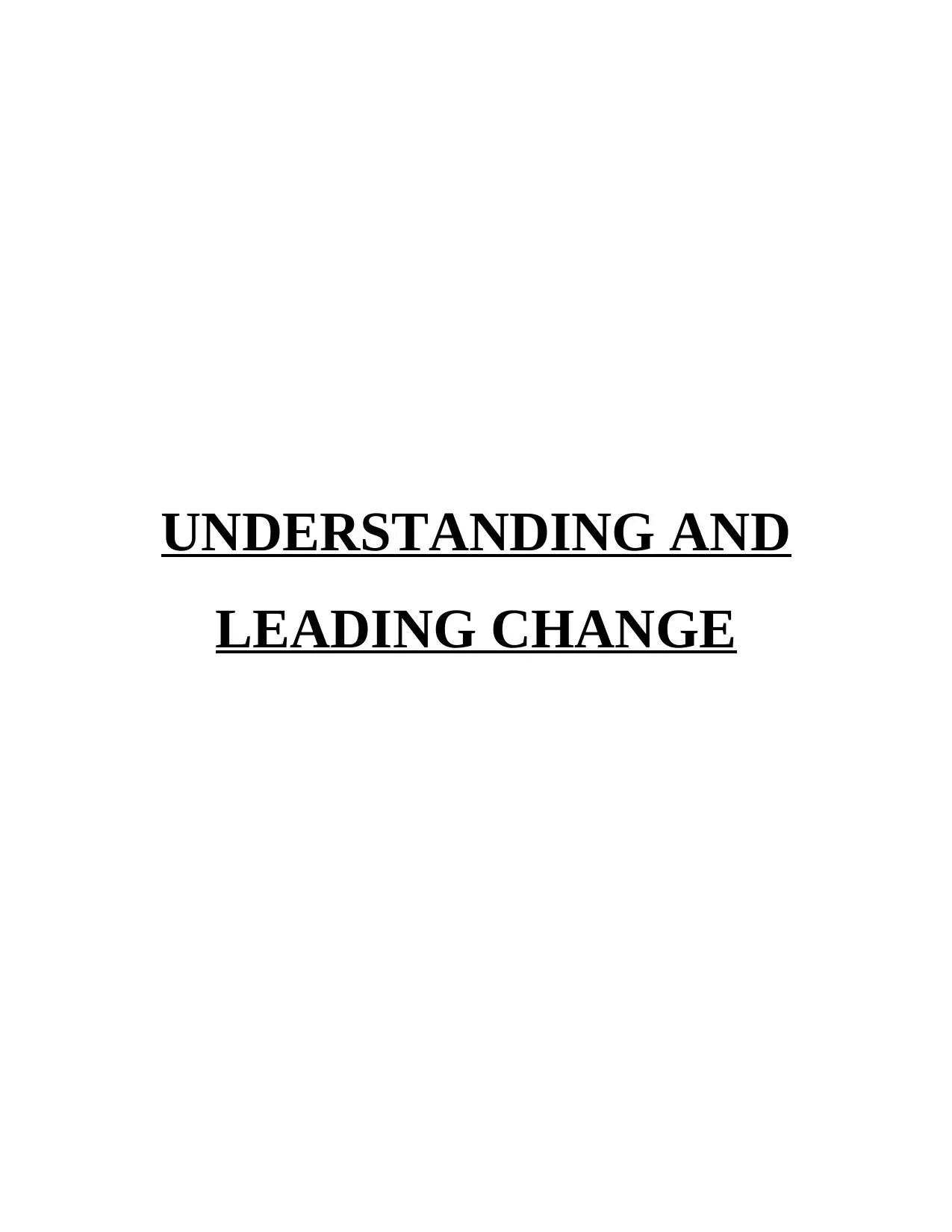
UNDERSTANDING AND
LEADING CHANGE
LEADING CHANGE
Secure Best Marks with AI Grader
Need help grading? Try our AI Grader for instant feedback on your assignments.
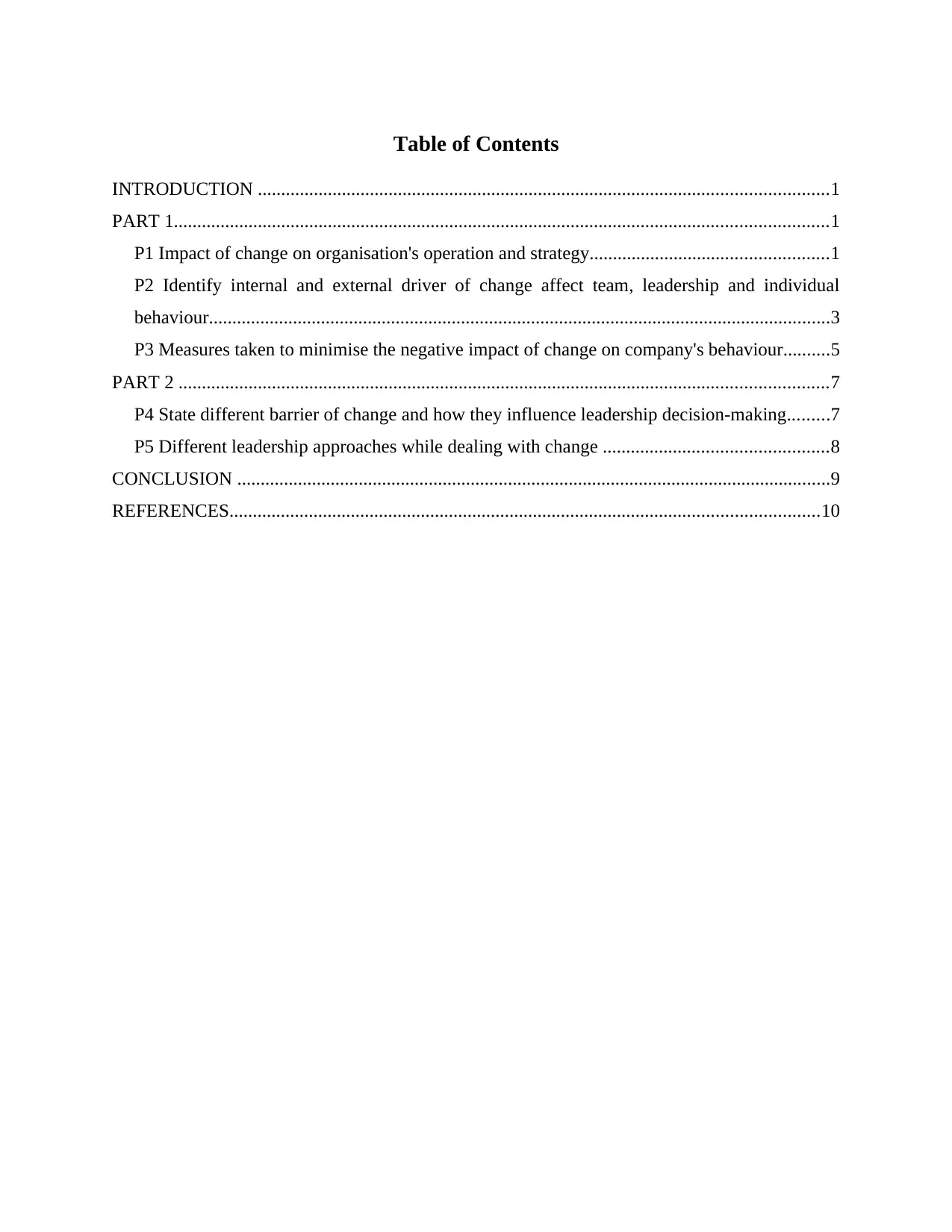
Table of Contents
INTRODUCTION ..........................................................................................................................1
PART 1............................................................................................................................................1
P1 Impact of change on organisation's operation and strategy...................................................1
P2 Identify internal and external driver of change affect team, leadership and individual
behaviour.....................................................................................................................................3
P3 Measures taken to minimise the negative impact of change on company's behaviour..........5
PART 2 ...........................................................................................................................................7
P4 State different barrier of change and how they influence leadership decision-making.........7
P5 Different leadership approaches while dealing with change ................................................8
CONCLUSION ...............................................................................................................................9
REFERENCES..............................................................................................................................10
INTRODUCTION ..........................................................................................................................1
PART 1............................................................................................................................................1
P1 Impact of change on organisation's operation and strategy...................................................1
P2 Identify internal and external driver of change affect team, leadership and individual
behaviour.....................................................................................................................................3
P3 Measures taken to minimise the negative impact of change on company's behaviour..........5
PART 2 ...........................................................................................................................................7
P4 State different barrier of change and how they influence leadership decision-making.........7
P5 Different leadership approaches while dealing with change ................................................8
CONCLUSION ...............................................................................................................................9
REFERENCES..............................................................................................................................10
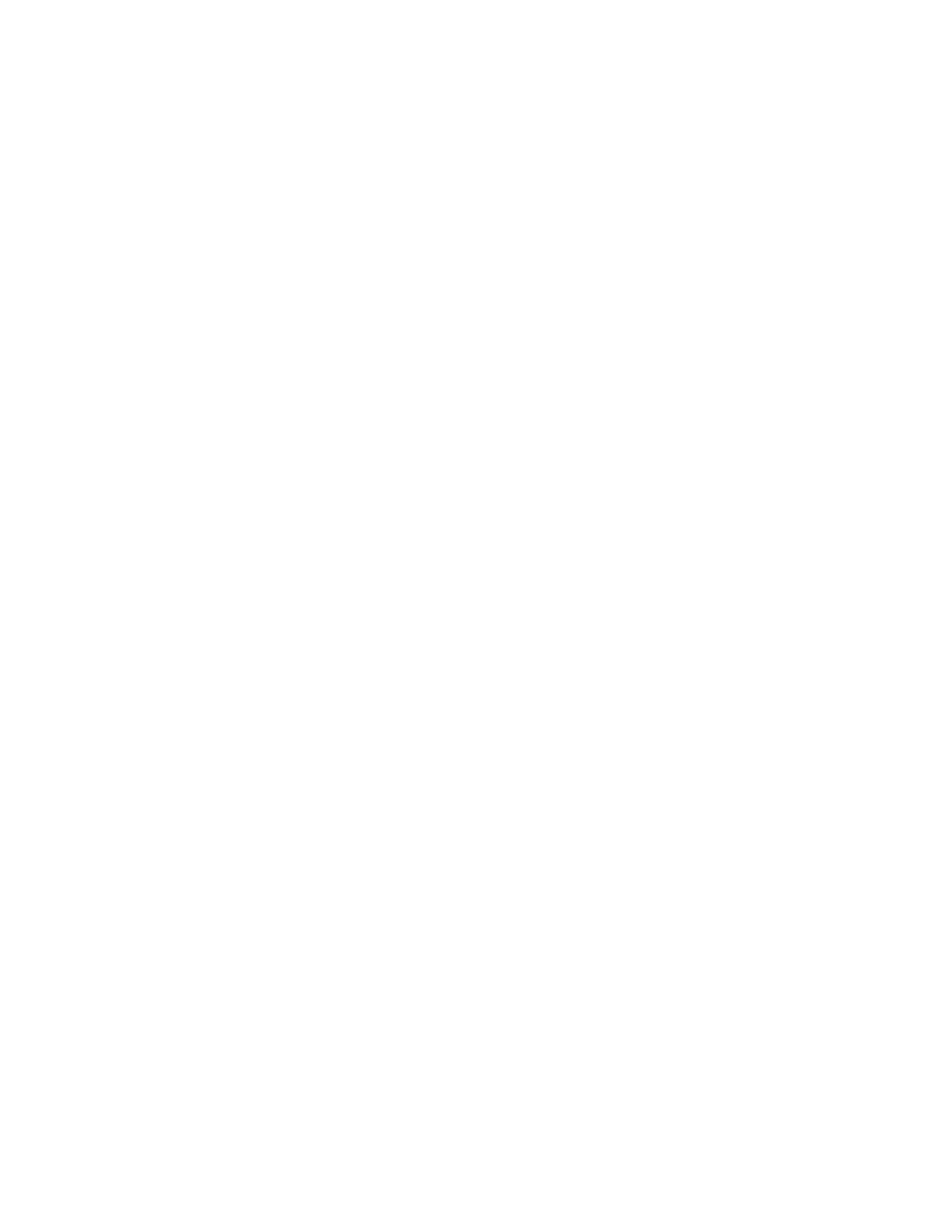
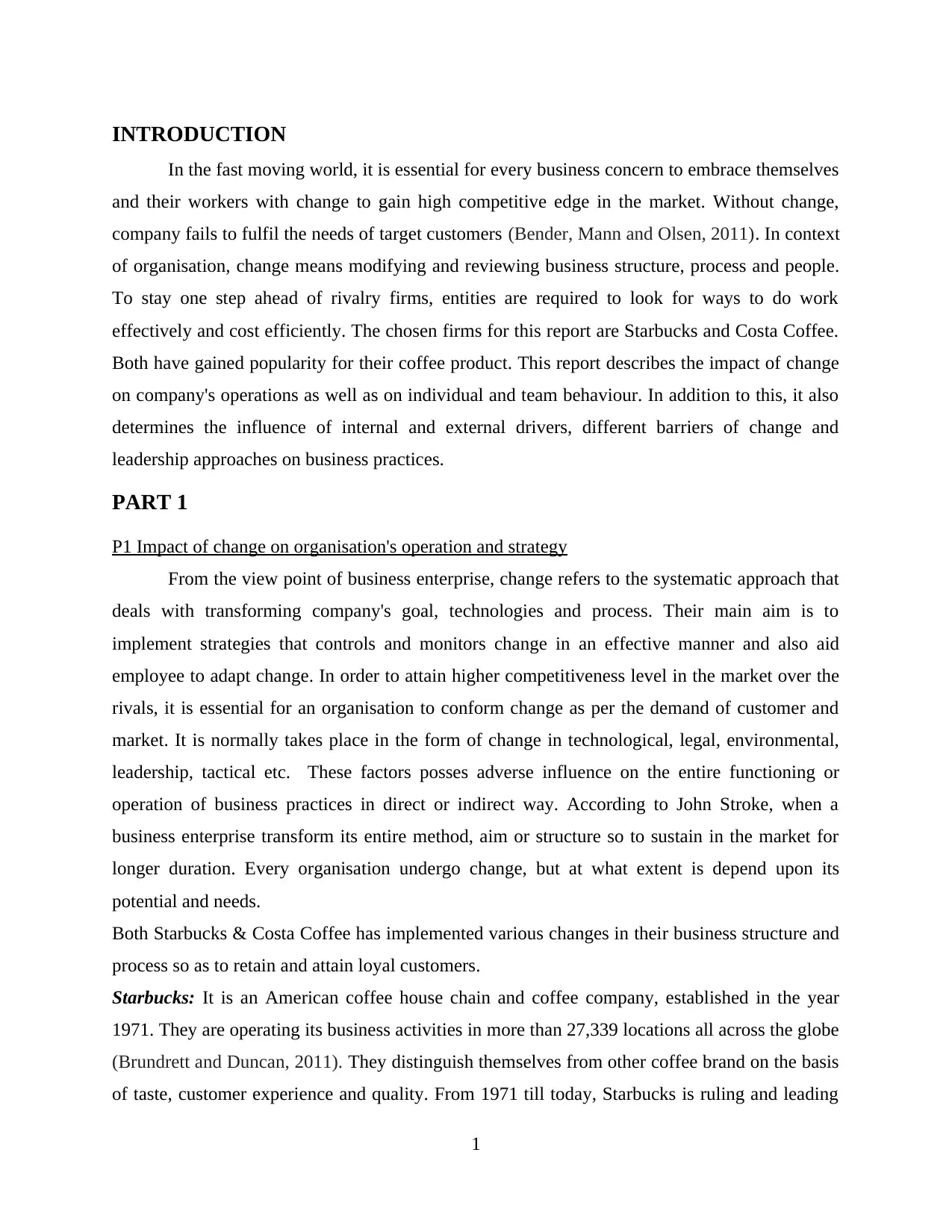
INTRODUCTION
In the fast moving world, it is essential for every business concern to embrace themselves
and their workers with change to gain high competitive edge in the market. Without change,
company fails to fulfil the needs of target customers (Bender, Mann and Olsen, 2011). In context
of organisation, change means modifying and reviewing business structure, process and people.
To stay one step ahead of rivalry firms, entities are required to look for ways to do work
effectively and cost efficiently. The chosen firms for this report are Starbucks and Costa Coffee.
Both have gained popularity for their coffee product. This report describes the impact of change
on company's operations as well as on individual and team behaviour. In addition to this, it also
determines the influence of internal and external drivers, different barriers of change and
leadership approaches on business practices.
PART 1
P1 Impact of change on organisation's operation and strategy
From the view point of business enterprise, change refers to the systematic approach that
deals with transforming company's goal, technologies and process. Their main aim is to
implement strategies that controls and monitors change in an effective manner and also aid
employee to adapt change. In order to attain higher competitiveness level in the market over the
rivals, it is essential for an organisation to conform change as per the demand of customer and
market. It is normally takes place in the form of change in technological, legal, environmental,
leadership, tactical etc. These factors posses adverse influence on the entire functioning or
operation of business practices in direct or indirect way. According to John Stroke, when a
business enterprise transform its entire method, aim or structure so to sustain in the market for
longer duration. Every organisation undergo change, but at what extent is depend upon its
potential and needs.
Both Starbucks & Costa Coffee has implemented various changes in their business structure and
process so as to retain and attain loyal customers.
Starbucks: It is an American coffee house chain and coffee company, established in the year
1971. They are operating its business activities in more than 27,339 locations all across the globe
(Brundrett and Duncan, 2011). They distinguish themselves from other coffee brand on the basis
of taste, customer experience and quality. From 1971 till today, Starbucks is ruling and leading
1
In the fast moving world, it is essential for every business concern to embrace themselves
and their workers with change to gain high competitive edge in the market. Without change,
company fails to fulfil the needs of target customers (Bender, Mann and Olsen, 2011). In context
of organisation, change means modifying and reviewing business structure, process and people.
To stay one step ahead of rivalry firms, entities are required to look for ways to do work
effectively and cost efficiently. The chosen firms for this report are Starbucks and Costa Coffee.
Both have gained popularity for their coffee product. This report describes the impact of change
on company's operations as well as on individual and team behaviour. In addition to this, it also
determines the influence of internal and external drivers, different barriers of change and
leadership approaches on business practices.
PART 1
P1 Impact of change on organisation's operation and strategy
From the view point of business enterprise, change refers to the systematic approach that
deals with transforming company's goal, technologies and process. Their main aim is to
implement strategies that controls and monitors change in an effective manner and also aid
employee to adapt change. In order to attain higher competitiveness level in the market over the
rivals, it is essential for an organisation to conform change as per the demand of customer and
market. It is normally takes place in the form of change in technological, legal, environmental,
leadership, tactical etc. These factors posses adverse influence on the entire functioning or
operation of business practices in direct or indirect way. According to John Stroke, when a
business enterprise transform its entire method, aim or structure so to sustain in the market for
longer duration. Every organisation undergo change, but at what extent is depend upon its
potential and needs.
Both Starbucks & Costa Coffee has implemented various changes in their business structure and
process so as to retain and attain loyal customers.
Starbucks: It is an American coffee house chain and coffee company, established in the year
1971. They are operating its business activities in more than 27,339 locations all across the globe
(Brundrett and Duncan, 2011). They distinguish themselves from other coffee brand on the basis
of taste, customer experience and quality. From 1971 till today, Starbucks is ruling and leading
1
Secure Best Marks with AI Grader
Need help grading? Try our AI Grader for instant feedback on your assignments.
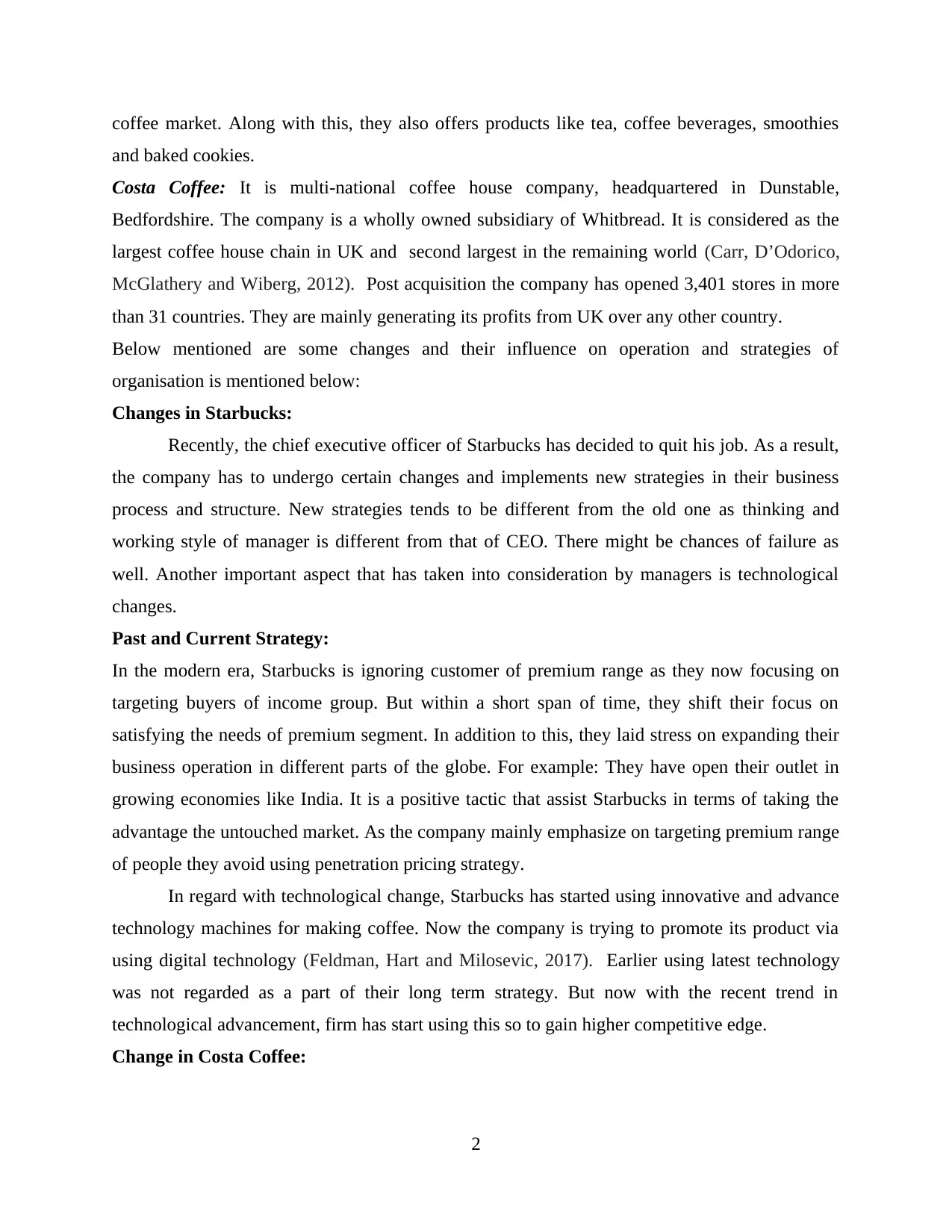
coffee market. Along with this, they also offers products like tea, coffee beverages, smoothies
and baked cookies.
Costa Coffee: It is multi-national coffee house company, headquartered in Dunstable,
Bedfordshire. The company is a wholly owned subsidiary of Whitbread. It is considered as the
largest coffee house chain in UK and second largest in the remaining world (Carr, D’Odorico,
McGlathery and Wiberg, 2012). Post acquisition the company has opened 3,401 stores in more
than 31 countries. They are mainly generating its profits from UK over any other country.
Below mentioned are some changes and their influence on operation and strategies of
organisation is mentioned below:
Changes in Starbucks:
Recently, the chief executive officer of Starbucks has decided to quit his job. As a result,
the company has to undergo certain changes and implements new strategies in their business
process and structure. New strategies tends to be different from the old one as thinking and
working style of manager is different from that of CEO. There might be chances of failure as
well. Another important aspect that has taken into consideration by managers is technological
changes.
Past and Current Strategy:
In the modern era, Starbucks is ignoring customer of premium range as they now focusing on
targeting buyers of income group. But within a short span of time, they shift their focus on
satisfying the needs of premium segment. In addition to this, they laid stress on expanding their
business operation in different parts of the globe. For example: They have open their outlet in
growing economies like India. It is a positive tactic that assist Starbucks in terms of taking the
advantage the untouched market. As the company mainly emphasize on targeting premium range
of people they avoid using penetration pricing strategy.
In regard with technological change, Starbucks has started using innovative and advance
technology machines for making coffee. Now the company is trying to promote its product via
using digital technology (Feldman, Hart and Milosevic, 2017). Earlier using latest technology
was not regarded as a part of their long term strategy. But now with the recent trend in
technological advancement, firm has start using this so to gain higher competitive edge.
Change in Costa Coffee:
2
and baked cookies.
Costa Coffee: It is multi-national coffee house company, headquartered in Dunstable,
Bedfordshire. The company is a wholly owned subsidiary of Whitbread. It is considered as the
largest coffee house chain in UK and second largest in the remaining world (Carr, D’Odorico,
McGlathery and Wiberg, 2012). Post acquisition the company has opened 3,401 stores in more
than 31 countries. They are mainly generating its profits from UK over any other country.
Below mentioned are some changes and their influence on operation and strategies of
organisation is mentioned below:
Changes in Starbucks:
Recently, the chief executive officer of Starbucks has decided to quit his job. As a result,
the company has to undergo certain changes and implements new strategies in their business
process and structure. New strategies tends to be different from the old one as thinking and
working style of manager is different from that of CEO. There might be chances of failure as
well. Another important aspect that has taken into consideration by managers is technological
changes.
Past and Current Strategy:
In the modern era, Starbucks is ignoring customer of premium range as they now focusing on
targeting buyers of income group. But within a short span of time, they shift their focus on
satisfying the needs of premium segment. In addition to this, they laid stress on expanding their
business operation in different parts of the globe. For example: They have open their outlet in
growing economies like India. It is a positive tactic that assist Starbucks in terms of taking the
advantage the untouched market. As the company mainly emphasize on targeting premium range
of people they avoid using penetration pricing strategy.
In regard with technological change, Starbucks has started using innovative and advance
technology machines for making coffee. Now the company is trying to promote its product via
using digital technology (Feldman, Hart and Milosevic, 2017). Earlier using latest technology
was not regarded as a part of their long term strategy. But now with the recent trend in
technological advancement, firm has start using this so to gain higher competitive edge.
Change in Costa Coffee:
2
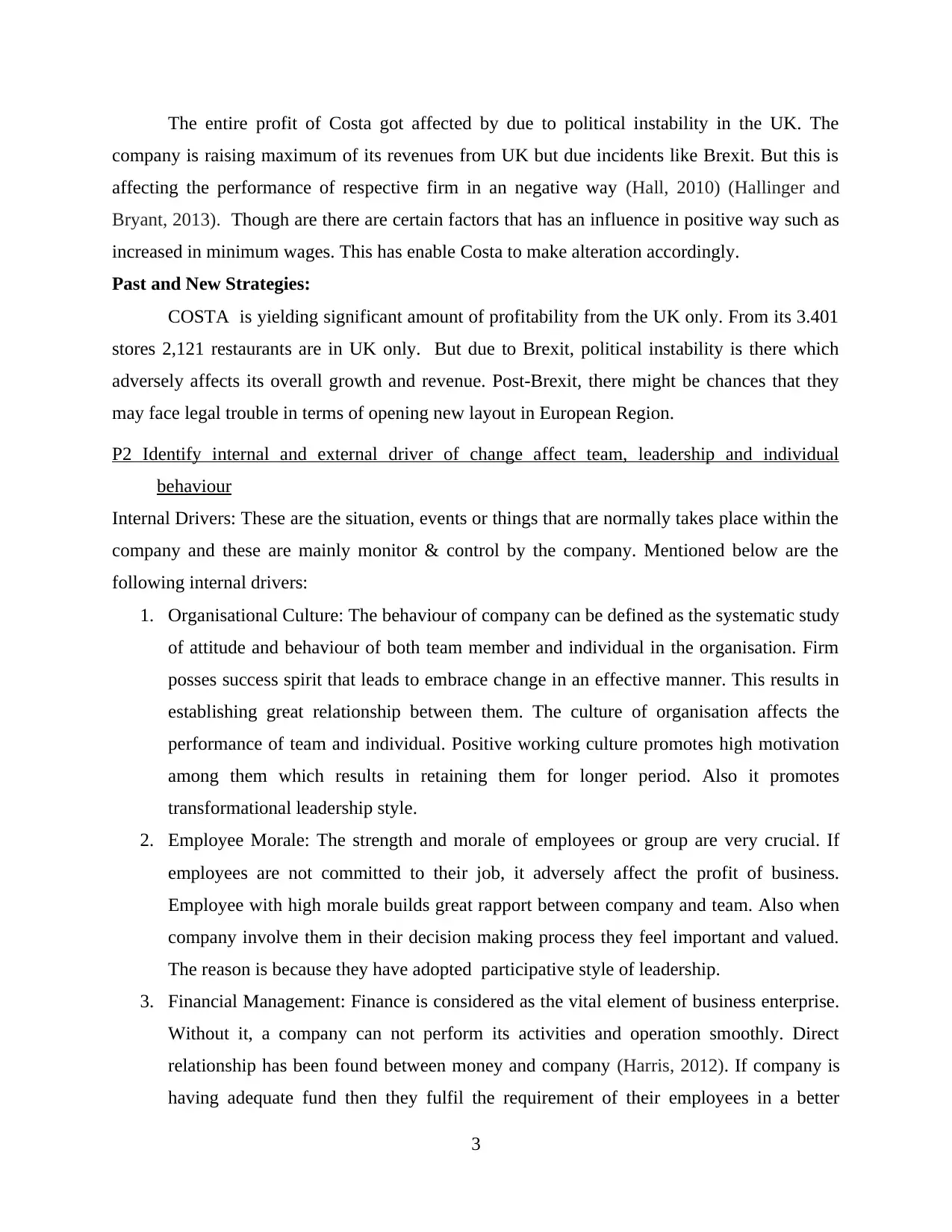
The entire profit of Costa got affected by due to political instability in the UK. The
company is raising maximum of its revenues from UK but due incidents like Brexit. But this is
affecting the performance of respective firm in an negative way (Hall, 2010) (Hallinger and
Bryant, 2013). Though are there are certain factors that has an influence in positive way such as
increased in minimum wages. This has enable Costa to make alteration accordingly.
Past and New Strategies:
COSTA is yielding significant amount of profitability from the UK only. From its 3.401
stores 2,121 restaurants are in UK only. But due to Brexit, political instability is there which
adversely affects its overall growth and revenue. Post-Brexit, there might be chances that they
may face legal trouble in terms of opening new layout in European Region.
P2 Identify internal and external driver of change affect team, leadership and individual
behaviour
Internal Drivers: These are the situation, events or things that are normally takes place within the
company and these are mainly monitor & control by the company. Mentioned below are the
following internal drivers:
1. Organisational Culture: The behaviour of company can be defined as the systematic study
of attitude and behaviour of both team member and individual in the organisation. Firm
posses success spirit that leads to embrace change in an effective manner. This results in
establishing great relationship between them. The culture of organisation affects the
performance of team and individual. Positive working culture promotes high motivation
among them which results in retaining them for longer period. Also it promotes
transformational leadership style.
2. Employee Morale: The strength and morale of employees or group are very crucial. If
employees are not committed to their job, it adversely affect the profit of business.
Employee with high morale builds great rapport between company and team. Also when
company involve them in their decision making process they feel important and valued.
The reason is because they have adopted participative style of leadership.
3. Financial Management: Finance is considered as the vital element of business enterprise.
Without it, a company can not perform its activities and operation smoothly. Direct
relationship has been found between money and company (Harris, 2012). If company is
having adequate fund then they fulfil the requirement of their employees in a better
3
company is raising maximum of its revenues from UK but due incidents like Brexit. But this is
affecting the performance of respective firm in an negative way (Hall, 2010) (Hallinger and
Bryant, 2013). Though are there are certain factors that has an influence in positive way such as
increased in minimum wages. This has enable Costa to make alteration accordingly.
Past and New Strategies:
COSTA is yielding significant amount of profitability from the UK only. From its 3.401
stores 2,121 restaurants are in UK only. But due to Brexit, political instability is there which
adversely affects its overall growth and revenue. Post-Brexit, there might be chances that they
may face legal trouble in terms of opening new layout in European Region.
P2 Identify internal and external driver of change affect team, leadership and individual
behaviour
Internal Drivers: These are the situation, events or things that are normally takes place within the
company and these are mainly monitor & control by the company. Mentioned below are the
following internal drivers:
1. Organisational Culture: The behaviour of company can be defined as the systematic study
of attitude and behaviour of both team member and individual in the organisation. Firm
posses success spirit that leads to embrace change in an effective manner. This results in
establishing great relationship between them. The culture of organisation affects the
performance of team and individual. Positive working culture promotes high motivation
among them which results in retaining them for longer period. Also it promotes
transformational leadership style.
2. Employee Morale: The strength and morale of employees or group are very crucial. If
employees are not committed to their job, it adversely affect the profit of business.
Employee with high morale builds great rapport between company and team. Also when
company involve them in their decision making process they feel important and valued.
The reason is because they have adopted participative style of leadership.
3. Financial Management: Finance is considered as the vital element of business enterprise.
Without it, a company can not perform its activities and operation smoothly. Direct
relationship has been found between money and company (Harris, 2012). If company is
having adequate fund then they fulfil the requirement of their employees in a better
3
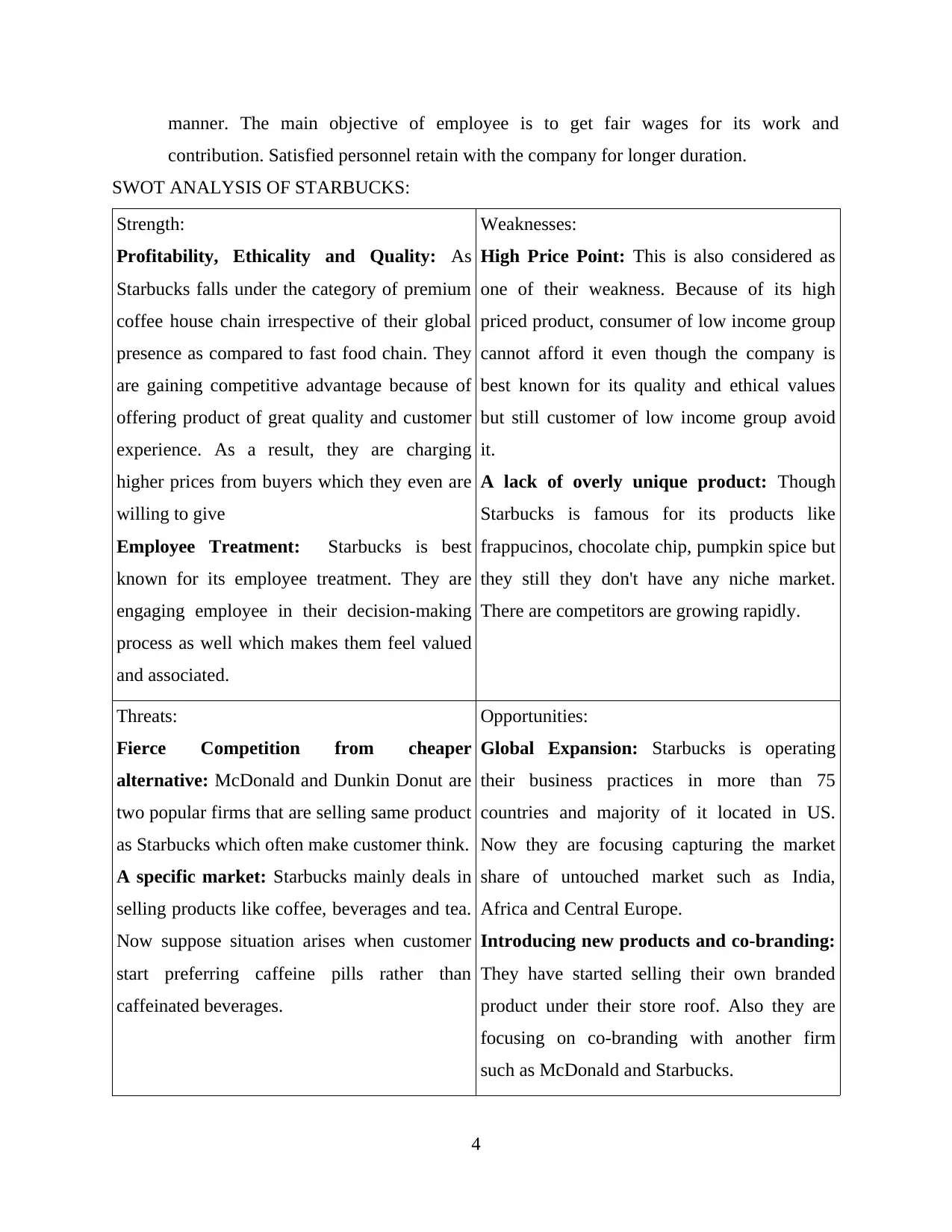
manner. The main objective of employee is to get fair wages for its work and
contribution. Satisfied personnel retain with the company for longer duration.
SWOT ANALYSIS OF STARBUCKS:
Strength:
Profitability, Ethicality and Quality: As
Starbucks falls under the category of premium
coffee house chain irrespective of their global
presence as compared to fast food chain. They
are gaining competitive advantage because of
offering product of great quality and customer
experience. As a result, they are charging
higher prices from buyers which they even are
willing to give
Employee Treatment: Starbucks is best
known for its employee treatment. They are
engaging employee in their decision-making
process as well which makes them feel valued
and associated.
Weaknesses:
High Price Point: This is also considered as
one of their weakness. Because of its high
priced product, consumer of low income group
cannot afford it even though the company is
best known for its quality and ethical values
but still customer of low income group avoid
it.
A lack of overly unique product: Though
Starbucks is famous for its products like
frappucinos, chocolate chip, pumpkin spice but
they still they don't have any niche market.
There are competitors are growing rapidly.
Threats:
Fierce Competition from cheaper
alternative: McDonald and Dunkin Donut are
two popular firms that are selling same product
as Starbucks which often make customer think.
A specific market: Starbucks mainly deals in
selling products like coffee, beverages and tea.
Now suppose situation arises when customer
start preferring caffeine pills rather than
caffeinated beverages.
Opportunities:
Global Expansion: Starbucks is operating
their business practices in more than 75
countries and majority of it located in US.
Now they are focusing capturing the market
share of untouched market such as India,
Africa and Central Europe.
Introducing new products and co-branding:
They have started selling their own branded
product under their store roof. Also they are
focusing on co-branding with another firm
such as McDonald and Starbucks.
4
contribution. Satisfied personnel retain with the company for longer duration.
SWOT ANALYSIS OF STARBUCKS:
Strength:
Profitability, Ethicality and Quality: As
Starbucks falls under the category of premium
coffee house chain irrespective of their global
presence as compared to fast food chain. They
are gaining competitive advantage because of
offering product of great quality and customer
experience. As a result, they are charging
higher prices from buyers which they even are
willing to give
Employee Treatment: Starbucks is best
known for its employee treatment. They are
engaging employee in their decision-making
process as well which makes them feel valued
and associated.
Weaknesses:
High Price Point: This is also considered as
one of their weakness. Because of its high
priced product, consumer of low income group
cannot afford it even though the company is
best known for its quality and ethical values
but still customer of low income group avoid
it.
A lack of overly unique product: Though
Starbucks is famous for its products like
frappucinos, chocolate chip, pumpkin spice but
they still they don't have any niche market.
There are competitors are growing rapidly.
Threats:
Fierce Competition from cheaper
alternative: McDonald and Dunkin Donut are
two popular firms that are selling same product
as Starbucks which often make customer think.
A specific market: Starbucks mainly deals in
selling products like coffee, beverages and tea.
Now suppose situation arises when customer
start preferring caffeine pills rather than
caffeinated beverages.
Opportunities:
Global Expansion: Starbucks is operating
their business practices in more than 75
countries and majority of it located in US.
Now they are focusing capturing the market
share of untouched market such as India,
Africa and Central Europe.
Introducing new products and co-branding:
They have started selling their own branded
product under their store roof. Also they are
focusing on co-branding with another firm
such as McDonald and Starbucks.
4
Paraphrase This Document
Need a fresh take? Get an instant paraphrase of this document with our AI Paraphraser
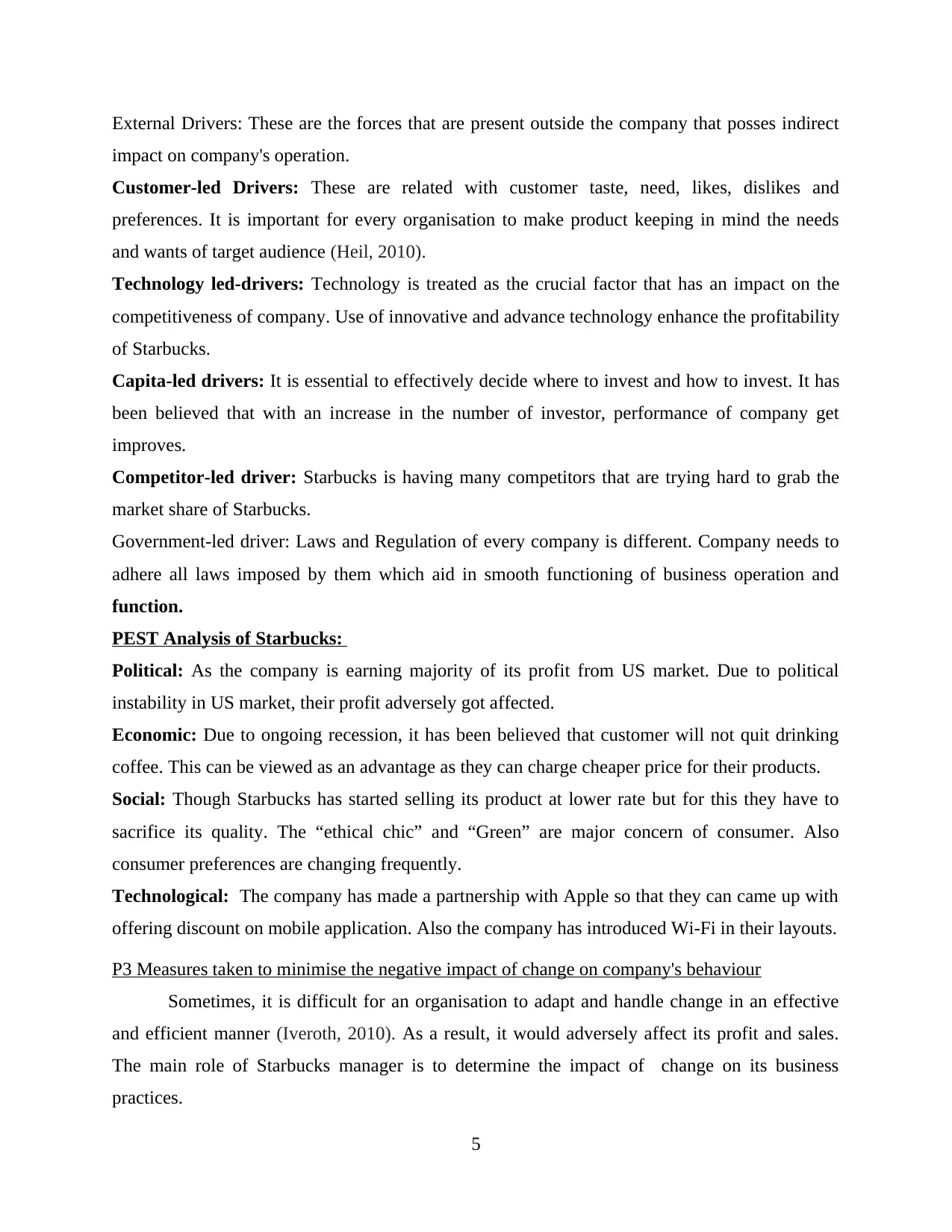
External Drivers: These are the forces that are present outside the company that posses indirect
impact on company's operation.
Customer-led Drivers: These are related with customer taste, need, likes, dislikes and
preferences. It is important for every organisation to make product keeping in mind the needs
and wants of target audience (Heil, 2010).
Technology led-drivers: Technology is treated as the crucial factor that has an impact on the
competitiveness of company. Use of innovative and advance technology enhance the profitability
of Starbucks.
Capita-led drivers: It is essential to effectively decide where to invest and how to invest. It has
been believed that with an increase in the number of investor, performance of company get
improves.
Competitor-led driver: Starbucks is having many competitors that are trying hard to grab the
market share of Starbucks.
Government-led driver: Laws and Regulation of every company is different. Company needs to
adhere all laws imposed by them which aid in smooth functioning of business operation and
function.
PEST Analysis of Starbucks:
Political: As the company is earning majority of its profit from US market. Due to political
instability in US market, their profit adversely got affected.
Economic: Due to ongoing recession, it has been believed that customer will not quit drinking
coffee. This can be viewed as an advantage as they can charge cheaper price for their products.
Social: Though Starbucks has started selling its product at lower rate but for this they have to
sacrifice its quality. The “ethical chic” and “Green” are major concern of consumer. Also
consumer preferences are changing frequently.
Technological: The company has made a partnership with Apple so that they can came up with
offering discount on mobile application. Also the company has introduced Wi-Fi in their layouts.
P3 Measures taken to minimise the negative impact of change on company's behaviour
Sometimes, it is difficult for an organisation to adapt and handle change in an effective
and efficient manner (Iveroth, 2010). As a result, it would adversely affect its profit and sales.
The main role of Starbucks manager is to determine the impact of change on its business
practices.
5
impact on company's operation.
Customer-led Drivers: These are related with customer taste, need, likes, dislikes and
preferences. It is important for every organisation to make product keeping in mind the needs
and wants of target audience (Heil, 2010).
Technology led-drivers: Technology is treated as the crucial factor that has an impact on the
competitiveness of company. Use of innovative and advance technology enhance the profitability
of Starbucks.
Capita-led drivers: It is essential to effectively decide where to invest and how to invest. It has
been believed that with an increase in the number of investor, performance of company get
improves.
Competitor-led driver: Starbucks is having many competitors that are trying hard to grab the
market share of Starbucks.
Government-led driver: Laws and Regulation of every company is different. Company needs to
adhere all laws imposed by them which aid in smooth functioning of business operation and
function.
PEST Analysis of Starbucks:
Political: As the company is earning majority of its profit from US market. Due to political
instability in US market, their profit adversely got affected.
Economic: Due to ongoing recession, it has been believed that customer will not quit drinking
coffee. This can be viewed as an advantage as they can charge cheaper price for their products.
Social: Though Starbucks has started selling its product at lower rate but for this they have to
sacrifice its quality. The “ethical chic” and “Green” are major concern of consumer. Also
consumer preferences are changing frequently.
Technological: The company has made a partnership with Apple so that they can came up with
offering discount on mobile application. Also the company has introduced Wi-Fi in their layouts.
P3 Measures taken to minimise the negative impact of change on company's behaviour
Sometimes, it is difficult for an organisation to adapt and handle change in an effective
and efficient manner (Iveroth, 2010). As a result, it would adversely affect its profit and sales.
The main role of Starbucks manager is to determine the impact of change on its business
practices.
5
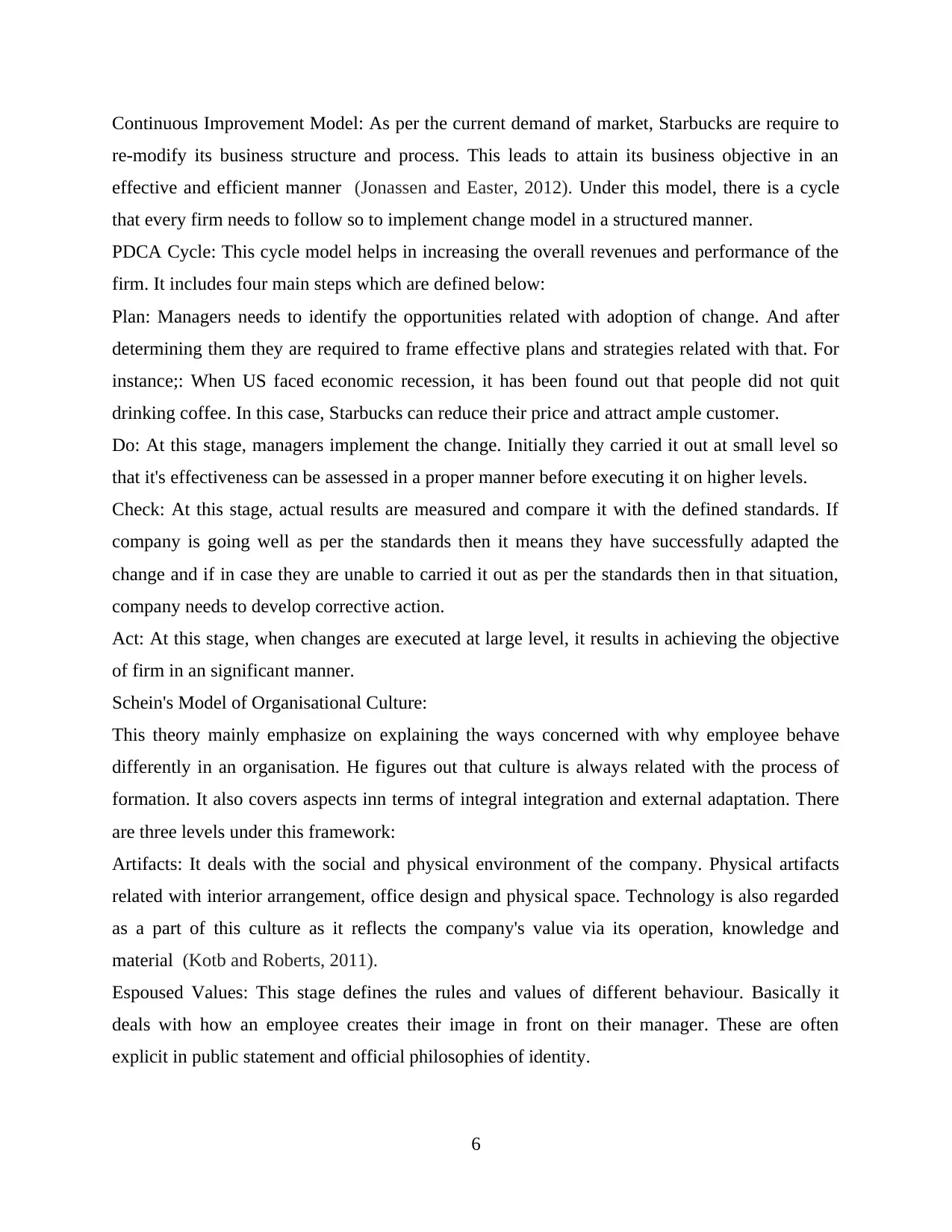
Continuous Improvement Model: As per the current demand of market, Starbucks are require to
re-modify its business structure and process. This leads to attain its business objective in an
effective and efficient manner (Jonassen and Easter, 2012). Under this model, there is a cycle
that every firm needs to follow so to implement change model in a structured manner.
PDCA Cycle: This cycle model helps in increasing the overall revenues and performance of the
firm. It includes four main steps which are defined below:
Plan: Managers needs to identify the opportunities related with adoption of change. And after
determining them they are required to frame effective plans and strategies related with that. For
instance;: When US faced economic recession, it has been found out that people did not quit
drinking coffee. In this case, Starbucks can reduce their price and attract ample customer.
Do: At this stage, managers implement the change. Initially they carried it out at small level so
that it's effectiveness can be assessed in a proper manner before executing it on higher levels.
Check: At this stage, actual results are measured and compare it with the defined standards. If
company is going well as per the standards then it means they have successfully adapted the
change and if in case they are unable to carried it out as per the standards then in that situation,
company needs to develop corrective action.
Act: At this stage, when changes are executed at large level, it results in achieving the objective
of firm in an significant manner.
Schein's Model of Organisational Culture:
This theory mainly emphasize on explaining the ways concerned with why employee behave
differently in an organisation. He figures out that culture is always related with the process of
formation. It also covers aspects inn terms of integral integration and external adaptation. There
are three levels under this framework:
Artifacts: It deals with the social and physical environment of the company. Physical artifacts
related with interior arrangement, office design and physical space. Technology is also regarded
as a part of this culture as it reflects the company's value via its operation, knowledge and
material (Kotb and Roberts, 2011).
Espoused Values: This stage defines the rules and values of different behaviour. Basically it
deals with how an employee creates their image in front on their manager. These are often
explicit in public statement and official philosophies of identity.
6
re-modify its business structure and process. This leads to attain its business objective in an
effective and efficient manner (Jonassen and Easter, 2012). Under this model, there is a cycle
that every firm needs to follow so to implement change model in a structured manner.
PDCA Cycle: This cycle model helps in increasing the overall revenues and performance of the
firm. It includes four main steps which are defined below:
Plan: Managers needs to identify the opportunities related with adoption of change. And after
determining them they are required to frame effective plans and strategies related with that. For
instance;: When US faced economic recession, it has been found out that people did not quit
drinking coffee. In this case, Starbucks can reduce their price and attract ample customer.
Do: At this stage, managers implement the change. Initially they carried it out at small level so
that it's effectiveness can be assessed in a proper manner before executing it on higher levels.
Check: At this stage, actual results are measured and compare it with the defined standards. If
company is going well as per the standards then it means they have successfully adapted the
change and if in case they are unable to carried it out as per the standards then in that situation,
company needs to develop corrective action.
Act: At this stage, when changes are executed at large level, it results in achieving the objective
of firm in an significant manner.
Schein's Model of Organisational Culture:
This theory mainly emphasize on explaining the ways concerned with why employee behave
differently in an organisation. He figures out that culture is always related with the process of
formation. It also covers aspects inn terms of integral integration and external adaptation. There
are three levels under this framework:
Artifacts: It deals with the social and physical environment of the company. Physical artifacts
related with interior arrangement, office design and physical space. Technology is also regarded
as a part of this culture as it reflects the company's value via its operation, knowledge and
material (Kotb and Roberts, 2011).
Espoused Values: This stage defines the rules and values of different behaviour. Basically it
deals with how an employee creates their image in front on their manager. These are often
explicit in public statement and official philosophies of identity.
6
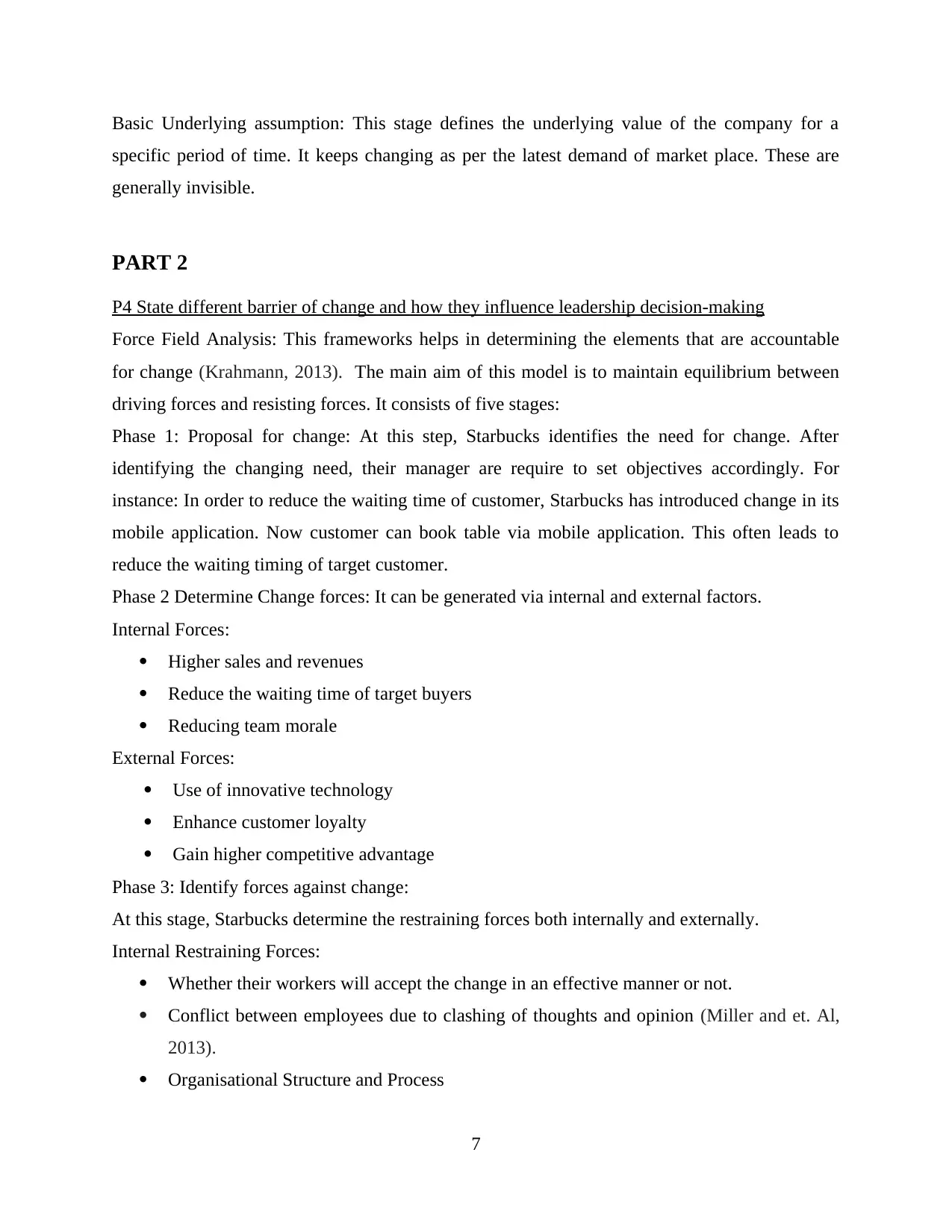
Basic Underlying assumption: This stage defines the underlying value of the company for a
specific period of time. It keeps changing as per the latest demand of market place. These are
generally invisible.
PART 2
P4 State different barrier of change and how they influence leadership decision-making
Force Field Analysis: This frameworks helps in determining the elements that are accountable
for change (Krahmann, 2013). The main aim of this model is to maintain equilibrium between
driving forces and resisting forces. It consists of five stages:
Phase 1: Proposal for change: At this step, Starbucks identifies the need for change. After
identifying the changing need, their manager are require to set objectives accordingly. For
instance: In order to reduce the waiting time of customer, Starbucks has introduced change in its
mobile application. Now customer can book table via mobile application. This often leads to
reduce the waiting timing of target customer.
Phase 2 Determine Change forces: It can be generated via internal and external factors.
Internal Forces:
Higher sales and revenues
Reduce the waiting time of target buyers
Reducing team morale
External Forces:
Use of innovative technology
Enhance customer loyalty
Gain higher competitive advantage
Phase 3: Identify forces against change:
At this stage, Starbucks determine the restraining forces both internally and externally.
Internal Restraining Forces:
Whether their workers will accept the change in an effective manner or not.
Conflict between employees due to clashing of thoughts and opinion (Miller and et. Al,
2013).
Organisational Structure and Process
7
specific period of time. It keeps changing as per the latest demand of market place. These are
generally invisible.
PART 2
P4 State different barrier of change and how they influence leadership decision-making
Force Field Analysis: This frameworks helps in determining the elements that are accountable
for change (Krahmann, 2013). The main aim of this model is to maintain equilibrium between
driving forces and resisting forces. It consists of five stages:
Phase 1: Proposal for change: At this step, Starbucks identifies the need for change. After
identifying the changing need, their manager are require to set objectives accordingly. For
instance: In order to reduce the waiting time of customer, Starbucks has introduced change in its
mobile application. Now customer can book table via mobile application. This often leads to
reduce the waiting timing of target customer.
Phase 2 Determine Change forces: It can be generated via internal and external factors.
Internal Forces:
Higher sales and revenues
Reduce the waiting time of target buyers
Reducing team morale
External Forces:
Use of innovative technology
Enhance customer loyalty
Gain higher competitive advantage
Phase 3: Identify forces against change:
At this stage, Starbucks determine the restraining forces both internally and externally.
Internal Restraining Forces:
Whether their workers will accept the change in an effective manner or not.
Conflict between employees due to clashing of thoughts and opinion (Miller and et. Al,
2013).
Organisational Structure and Process
7
Secure Best Marks with AI Grader
Need help grading? Try our AI Grader for instant feedback on your assignments.
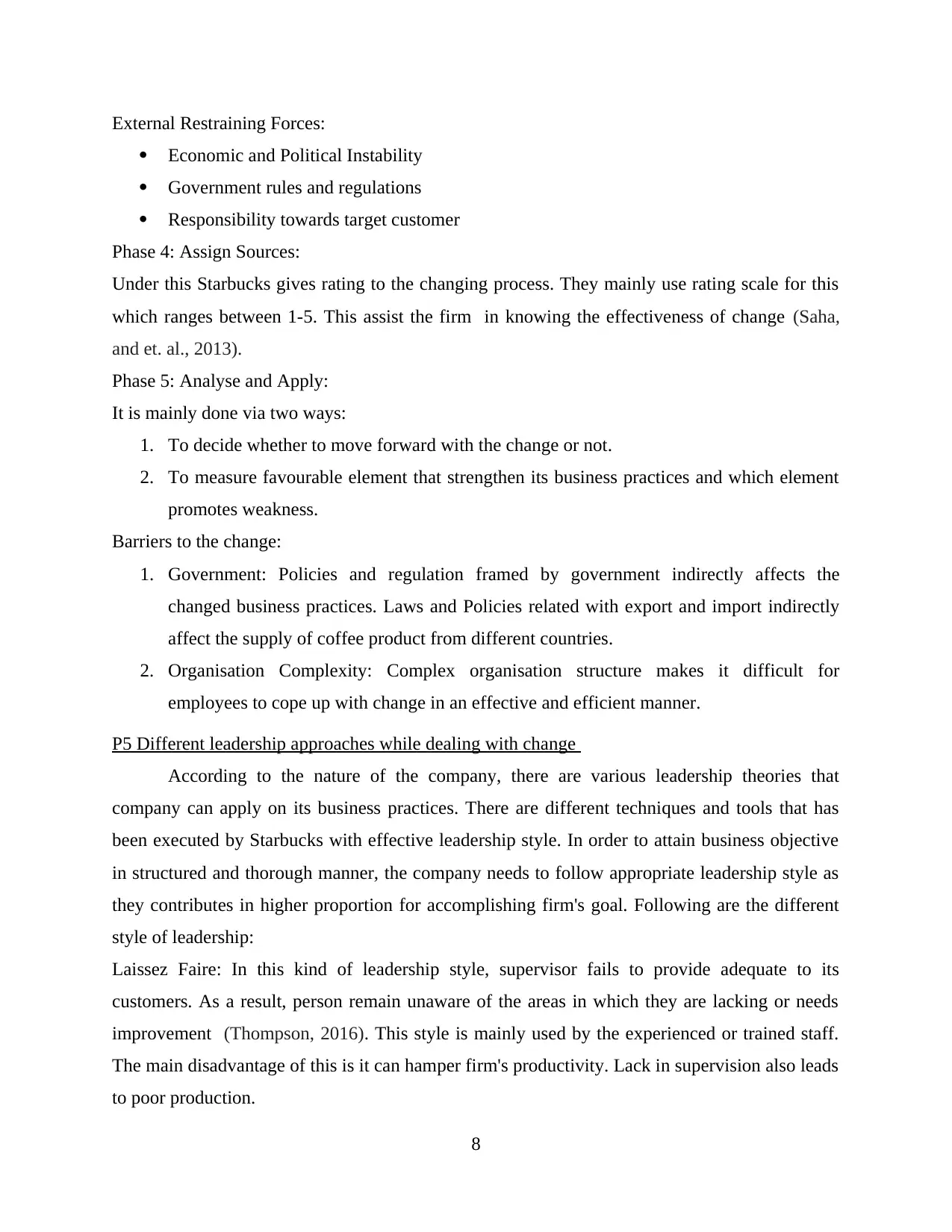
External Restraining Forces:
Economic and Political Instability
Government rules and regulations
Responsibility towards target customer
Phase 4: Assign Sources:
Under this Starbucks gives rating to the changing process. They mainly use rating scale for this
which ranges between 1-5. This assist the firm in knowing the effectiveness of change (Saha,
and et. al., 2013).
Phase 5: Analyse and Apply:
It is mainly done via two ways:
1. To decide whether to move forward with the change or not.
2. To measure favourable element that strengthen its business practices and which element
promotes weakness.
Barriers to the change:
1. Government: Policies and regulation framed by government indirectly affects the
changed business practices. Laws and Policies related with export and import indirectly
affect the supply of coffee product from different countries.
2. Organisation Complexity: Complex organisation structure makes it difficult for
employees to cope up with change in an effective and efficient manner.
P5 Different leadership approaches while dealing with change
According to the nature of the company, there are various leadership theories that
company can apply on its business practices. There are different techniques and tools that has
been executed by Starbucks with effective leadership style. In order to attain business objective
in structured and thorough manner, the company needs to follow appropriate leadership style as
they contributes in higher proportion for accomplishing firm's goal. Following are the different
style of leadership:
Laissez Faire: In this kind of leadership style, supervisor fails to provide adequate to its
customers. As a result, person remain unaware of the areas in which they are lacking or needs
improvement (Thompson, 2016). This style is mainly used by the experienced or trained staff.
The main disadvantage of this is it can hamper firm's productivity. Lack in supervision also leads
to poor production.
8
Economic and Political Instability
Government rules and regulations
Responsibility towards target customer
Phase 4: Assign Sources:
Under this Starbucks gives rating to the changing process. They mainly use rating scale for this
which ranges between 1-5. This assist the firm in knowing the effectiveness of change (Saha,
and et. al., 2013).
Phase 5: Analyse and Apply:
It is mainly done via two ways:
1. To decide whether to move forward with the change or not.
2. To measure favourable element that strengthen its business practices and which element
promotes weakness.
Barriers to the change:
1. Government: Policies and regulation framed by government indirectly affects the
changed business practices. Laws and Policies related with export and import indirectly
affect the supply of coffee product from different countries.
2. Organisation Complexity: Complex organisation structure makes it difficult for
employees to cope up with change in an effective and efficient manner.
P5 Different leadership approaches while dealing with change
According to the nature of the company, there are various leadership theories that
company can apply on its business practices. There are different techniques and tools that has
been executed by Starbucks with effective leadership style. In order to attain business objective
in structured and thorough manner, the company needs to follow appropriate leadership style as
they contributes in higher proportion for accomplishing firm's goal. Following are the different
style of leadership:
Laissez Faire: In this kind of leadership style, supervisor fails to provide adequate to its
customers. As a result, person remain unaware of the areas in which they are lacking or needs
improvement (Thompson, 2016). This style is mainly used by the experienced or trained staff.
The main disadvantage of this is it can hamper firm's productivity. Lack in supervision also leads
to poor production.
8
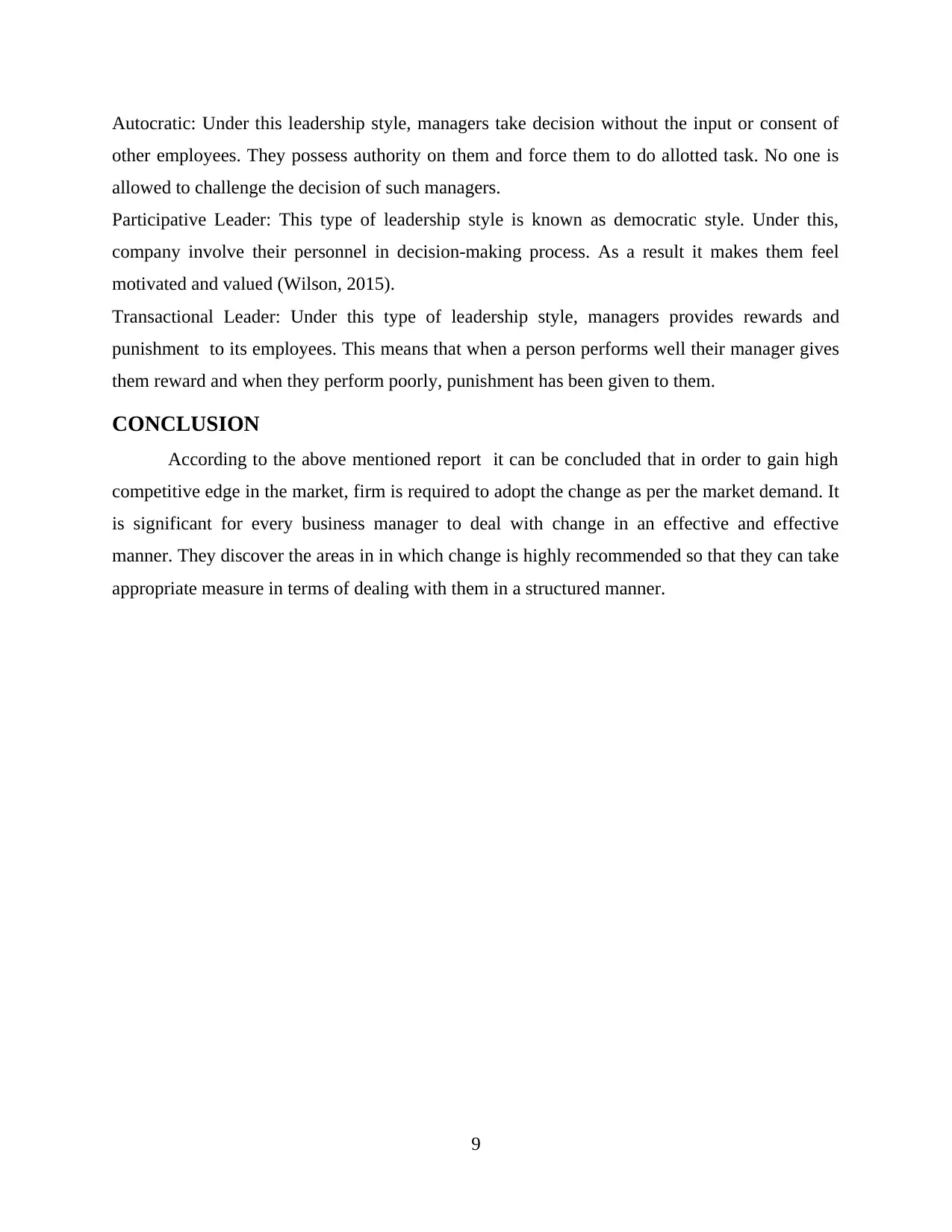
Autocratic: Under this leadership style, managers take decision without the input or consent of
other employees. They possess authority on them and force them to do allotted task. No one is
allowed to challenge the decision of such managers.
Participative Leader: This type of leadership style is known as democratic style. Under this,
company involve their personnel in decision-making process. As a result it makes them feel
motivated and valued (Wilson, 2015).
Transactional Leader: Under this type of leadership style, managers provides rewards and
punishment to its employees. This means that when a person performs well their manager gives
them reward and when they perform poorly, punishment has been given to them.
CONCLUSION
According to the above mentioned report it can be concluded that in order to gain high
competitive edge in the market, firm is required to adopt the change as per the market demand. It
is significant for every business manager to deal with change in an effective and effective
manner. They discover the areas in in which change is highly recommended so that they can take
appropriate measure in terms of dealing with them in a structured manner.
9
other employees. They possess authority on them and force them to do allotted task. No one is
allowed to challenge the decision of such managers.
Participative Leader: This type of leadership style is known as democratic style. Under this,
company involve their personnel in decision-making process. As a result it makes them feel
motivated and valued (Wilson, 2015).
Transactional Leader: Under this type of leadership style, managers provides rewards and
punishment to its employees. This means that when a person performs well their manager gives
them reward and when they perform poorly, punishment has been given to them.
CONCLUSION
According to the above mentioned report it can be concluded that in order to gain high
competitive edge in the market, firm is required to adopt the change as per the market demand. It
is significant for every business manager to deal with change in an effective and effective
manner. They discover the areas in in which change is highly recommended so that they can take
appropriate measure in terms of dealing with them in a structured manner.
9
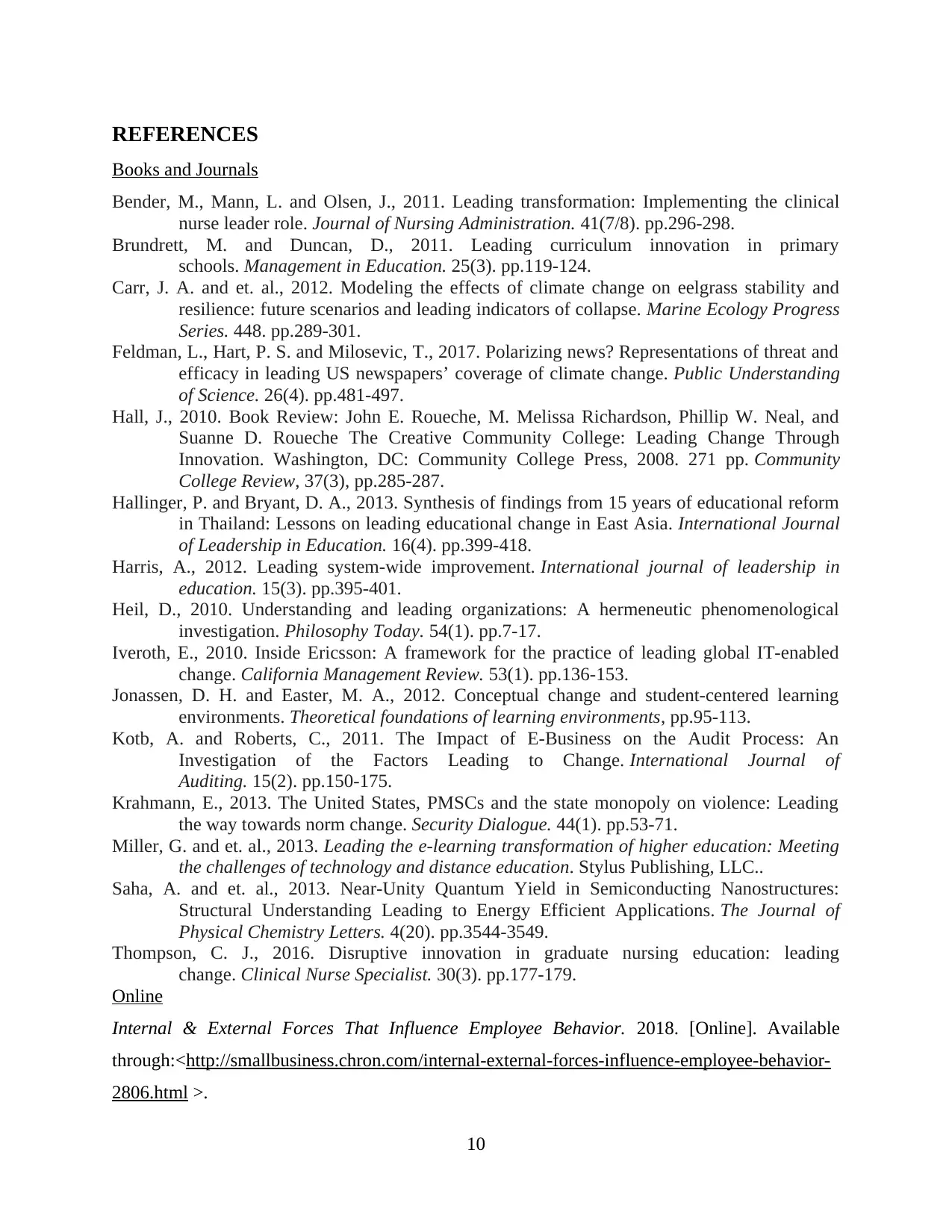
REFERENCES
Books and Journals
Bender, M., Mann, L. and Olsen, J., 2011. Leading transformation: Implementing the clinical
nurse leader role. Journal of Nursing Administration. 41(7/8). pp.296-298.
Brundrett, M. and Duncan, D., 2011. Leading curriculum innovation in primary
schools. Management in Education. 25(3). pp.119-124.
Carr, J. A. and et. al., 2012. Modeling the effects of climate change on eelgrass stability and
resilience: future scenarios and leading indicators of collapse. Marine Ecology Progress
Series. 448. pp.289-301.
Feldman, L., Hart, P. S. and Milosevic, T., 2017. Polarizing news? Representations of threat and
efficacy in leading US newspapers’ coverage of climate change. Public Understanding
of Science. 26(4). pp.481-497.
Hall, J., 2010. Book Review: John E. Roueche, M. Melissa Richardson, Phillip W. Neal, and
Suanne D. Roueche The Creative Community College: Leading Change Through
Innovation. Washington, DC: Community College Press, 2008. 271 pp. Community
College Review, 37(3), pp.285-287.
Hallinger, P. and Bryant, D. A., 2013. Synthesis of findings from 15 years of educational reform
in Thailand: Lessons on leading educational change in East Asia. International Journal
of Leadership in Education. 16(4). pp.399-418.
Harris, A., 2012. Leading system-wide improvement. International journal of leadership in
education. 15(3). pp.395-401.
Heil, D., 2010. Understanding and leading organizations: A hermeneutic phenomenological
investigation. Philosophy Today. 54(1). pp.7-17.
Iveroth, E., 2010. Inside Ericsson: A framework for the practice of leading global IT-enabled
change. California Management Review. 53(1). pp.136-153.
Jonassen, D. H. and Easter, M. A., 2012. Conceptual change and student-centered learning
environments. Theoretical foundations of learning environments, pp.95-113.
Kotb, A. and Roberts, C., 2011. The Impact of E‐Business on the Audit Process: An
Investigation of the Factors Leading to Change. International Journal of
Auditing. 15(2). pp.150-175.
Krahmann, E., 2013. The United States, PMSCs and the state monopoly on violence: Leading
the way towards norm change. Security Dialogue. 44(1). pp.53-71.
Miller, G. and et. al., 2013. Leading the e-learning transformation of higher education: Meeting
the challenges of technology and distance education. Stylus Publishing, LLC..
Saha, A. and et. al., 2013. Near-Unity Quantum Yield in Semiconducting Nanostructures:
Structural Understanding Leading to Energy Efficient Applications. The Journal of
Physical Chemistry Letters. 4(20). pp.3544-3549.
Thompson, C. J., 2016. Disruptive innovation in graduate nursing education: leading
change. Clinical Nurse Specialist. 30(3). pp.177-179.
Online
Internal & External Forces That Influence Employee Behavior. 2018. [Online]. Available
through:<http://smallbusiness.chron.com/internal-external-forces-influence-employee-behavior-
2806.html >.
10
Books and Journals
Bender, M., Mann, L. and Olsen, J., 2011. Leading transformation: Implementing the clinical
nurse leader role. Journal of Nursing Administration. 41(7/8). pp.296-298.
Brundrett, M. and Duncan, D., 2011. Leading curriculum innovation in primary
schools. Management in Education. 25(3). pp.119-124.
Carr, J. A. and et. al., 2012. Modeling the effects of climate change on eelgrass stability and
resilience: future scenarios and leading indicators of collapse. Marine Ecology Progress
Series. 448. pp.289-301.
Feldman, L., Hart, P. S. and Milosevic, T., 2017. Polarizing news? Representations of threat and
efficacy in leading US newspapers’ coverage of climate change. Public Understanding
of Science. 26(4). pp.481-497.
Hall, J., 2010. Book Review: John E. Roueche, M. Melissa Richardson, Phillip W. Neal, and
Suanne D. Roueche The Creative Community College: Leading Change Through
Innovation. Washington, DC: Community College Press, 2008. 271 pp. Community
College Review, 37(3), pp.285-287.
Hallinger, P. and Bryant, D. A., 2013. Synthesis of findings from 15 years of educational reform
in Thailand: Lessons on leading educational change in East Asia. International Journal
of Leadership in Education. 16(4). pp.399-418.
Harris, A., 2012. Leading system-wide improvement. International journal of leadership in
education. 15(3). pp.395-401.
Heil, D., 2010. Understanding and leading organizations: A hermeneutic phenomenological
investigation. Philosophy Today. 54(1). pp.7-17.
Iveroth, E., 2010. Inside Ericsson: A framework for the practice of leading global IT-enabled
change. California Management Review. 53(1). pp.136-153.
Jonassen, D. H. and Easter, M. A., 2012. Conceptual change and student-centered learning
environments. Theoretical foundations of learning environments, pp.95-113.
Kotb, A. and Roberts, C., 2011. The Impact of E‐Business on the Audit Process: An
Investigation of the Factors Leading to Change. International Journal of
Auditing. 15(2). pp.150-175.
Krahmann, E., 2013. The United States, PMSCs and the state monopoly on violence: Leading
the way towards norm change. Security Dialogue. 44(1). pp.53-71.
Miller, G. and et. al., 2013. Leading the e-learning transformation of higher education: Meeting
the challenges of technology and distance education. Stylus Publishing, LLC..
Saha, A. and et. al., 2013. Near-Unity Quantum Yield in Semiconducting Nanostructures:
Structural Understanding Leading to Energy Efficient Applications. The Journal of
Physical Chemistry Letters. 4(20). pp.3544-3549.
Thompson, C. J., 2016. Disruptive innovation in graduate nursing education: leading
change. Clinical Nurse Specialist. 30(3). pp.177-179.
Online
Internal & External Forces That Influence Employee Behavior. 2018. [Online]. Available
through:<http://smallbusiness.chron.com/internal-external-forces-influence-employee-behavior-
2806.html >.
10
Paraphrase This Document
Need a fresh take? Get an instant paraphrase of this document with our AI Paraphraser
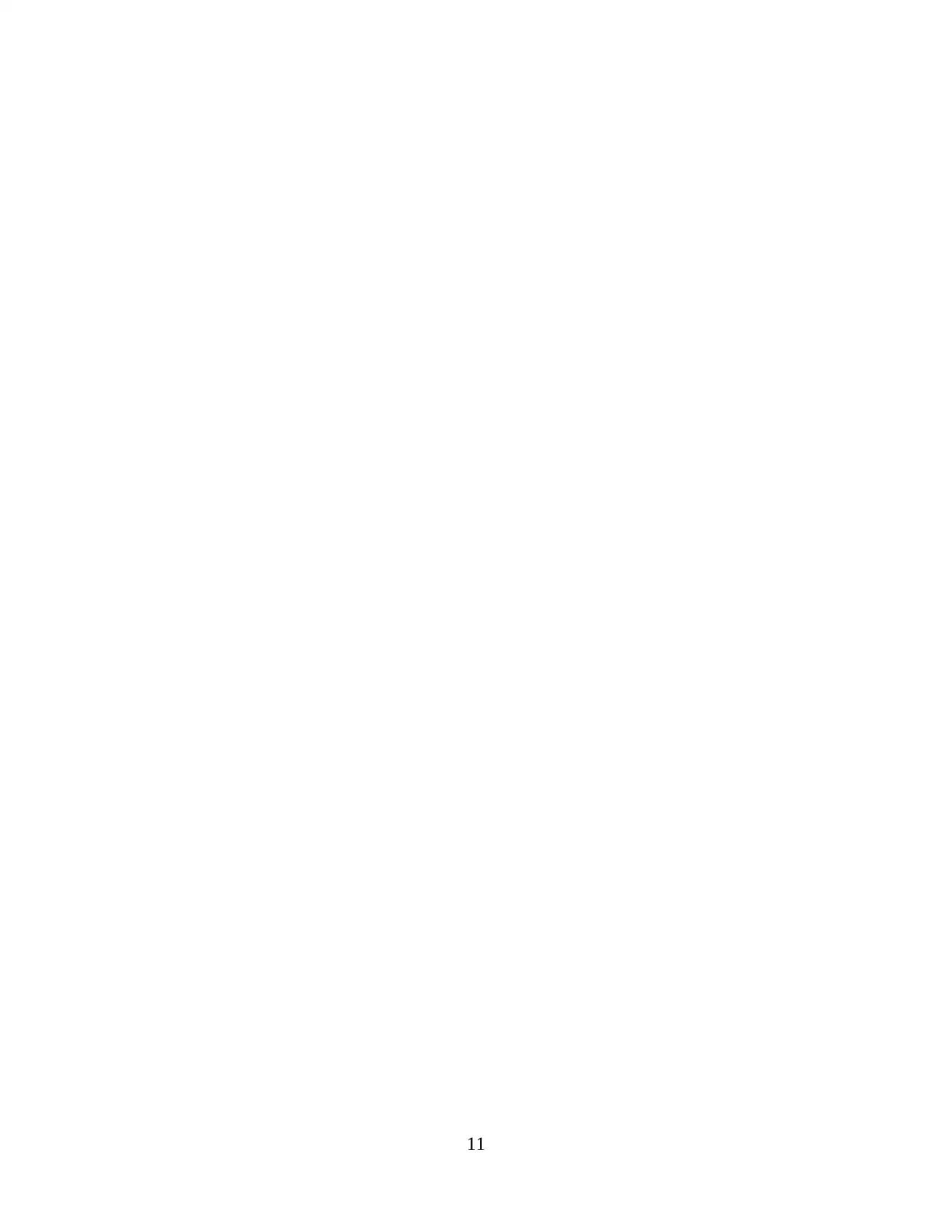
11
1 out of 14
Related Documents
Your All-in-One AI-Powered Toolkit for Academic Success.
+13062052269
info@desklib.com
Available 24*7 on WhatsApp / Email
![[object Object]](/_next/static/media/star-bottom.7253800d.svg)
Unlock your academic potential
© 2024 | Zucol Services PVT LTD | All rights reserved.





